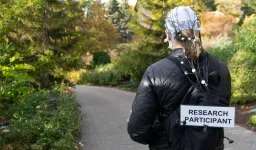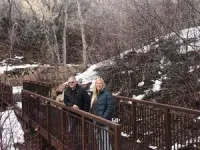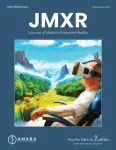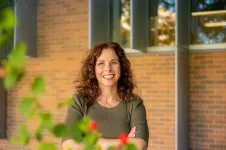(Press-News.org) New research from University of Utah psychology researchers is helping prove what American authors John Muir and Henry David Thoreau tried to teach more than 150 years ago: Time spent in nature is good for the heart and soul.
Amy McDonnell and David Strayer are showing it is good for your brain, too. Their latest research, conducted at the university’s Red Butte Garden, uses electroencephalography (EEG), which records electrical activity in the brain with small discs attached to the scalp, to measure participants’ attentional capacity.
“A walk in nature enhances certain executive control processes in the brain above and beyond the benefits associated with exercise,” concludes the study that appeared Tuesday in Scientific Reports, among the world’s most cited scientific journals. The paper contributes to growing body of scientific literature on the how natural settings contribute to a person’s physical and mental health. The university itself has recently established a new research group, Nature and Human Health Utah, that explores these issues and propose solutions for bridging the human-nature divide.
Many researchers suspect a primal need for nature is baked into humans’ DNA, and diminishing access to nature is putting our health at risk.
“There's an idea called biophilia that basically says that our evolution over hundreds of thousands of years has got us to have more of a connection or a love of natural living things,” said Strayer, a professor of psychology. “And our modern urban environment has become this dense urban jungle with cell phones and cars and computers and traffic, just the opposite of that kind of restorative environment.”
[You can see Strayer explore these ideas in his 2017 TEDx talk.]
Strayer’s past research into multitasking and distracted driving associated with cellphone use has drawn national attention. For the past decade, his lab has focused on how nature affects cognition. The new research was part of McDonnell’s dissertation as a grad student in Strayer’s Applied Cognition Lab. She has since completed her PhD and is continuing the attention research as a postdoctoral fellow with the University of Utah.
The study, conducted in 2022 between April and October, analyzed EEG data recorded on each of 92 participants immediately before and after they undertook a 40-minute walk. Half walked through Red Butte, the arboretum in the foothills just east of the university, and half through the nearby asphalt-laden medical campus.
“We start out by having participants do a really draining cognitive task in which they count backwards from 1,000 by sevens, which is really hard,” McDonnel said. “No matter how good you are at mental math, it gets pretty draining after 10 minutes. And then right after that, we give them an attention task.”
The idea was to deplete the participants’ attentional reserves before doing the standardized “Attention Network Task” and going for the walk, which they do without their electronic devices or talking to anyone along the way. They are randomly selected to either walk through the least built-up part of the arboretum along Red Butte Creek or through the adjacent U medical campus and parking lots. Both routes covered two miles with similar amounts of elevation gain.
“The participants that had walked in nature showed an improvement in their executive attention on that task, whereas the urban walkers did not, so then we know it's something unique about the environment that you're walking in,” McDonnell said. “We know exercise benefits executive attention as well, so we want to make sure both groups have comparable amounts of exercise.”
What sets this study apart from much of the existing research into the human-nature nexus is its reliance on EEG data as opposed to surveys and self-reporting, which do yield helpful information but can be highly subjective.
“This is probably one of the most rigorous studies in terms of controlling for and making sure that it's really the exposure in Red Butte” resulting in the observed cognitive effects, Strayer said.
McDonnell fitted each participant with a cap with holes to support an array of 32 electrodes that contact the scalp with the help of a special gel.
“It has electrodes that are placed all over the surface of the scalp,” Strayer said. “It records really very, very small voltages, but it's an active electrode system that provides beautiful brain maps.”
The maps revealed three components of attention, alerting, orienting and executive control.
Executive control occurs in the brain’s prefrontal cortex, an area critical for working memory, decision making, problem solving and coordinating disparate tasks.
“The kinds of things that we do on an everyday basis tend to heavily use those executive attentional networks,” Strayer said. “It's important in concentration and especially, so it's an essential component of higher order thinking.”
While the EEG and attention task results did not show much of a difference for alertness and orientation between the garden and the asphalt walkers, those on the nature walk exhibited improved executive control.
McDonnell and Strayer hope the findings can be refined to show what kind of natural settings result in optimal cognitive benefits, and how much exposure is needed to help.
“If you understand something about what's making us mentally and physically healthier, you could then potentially engineer our cities so that they supported that,” Strayer said.
The team is continuing the research at Red Butte, but now looking at how cellphone use affects the garden walkers’ responses. Strayer is sometimes asked why he studies both distraction and attention, which he sees as opposing sides of the same coin.
“It’s where the prefrontal cortex is overloaded, overstimulated, and you make all kinds of dangerous mistakes when you're multitasking behind the wheel,” he said. “But the antidote to that is being out in a natural environment, leave the phone in your pocket and then go out and walk the trails. The parts of the brain that have been overused during the daily commute are restored. You see and think more clearly.”
END
How a walk in nature restores attention
Neural research conducted at Utah's Red Butte Garden uses EEG to measure brain activity on subjects after walks through nature and parking lots.
2024-01-29
ELSE PRESS RELEASES FROM THIS DATE:
What is medical extended reality? New AMXRA guideline
2024-01-29
A new guideline to help define the emerging field of Medical Extended Reality. Which seeks to standardize terminology, categorize existing work, and provide a structured framework for future research development in MXR.
END ...
Emergency cardiovascular care impact goal outlines 3 target needs
2024-01-29
Statement Highlights:
Despite significant advances in research, education, clinical practice and community-based programs, survival from cardiac arrest remains low.
Significant disparities also exist in cardiac arrest outcomes.
This scientific statement specifically identifies impact goals to achieve or exceed by 2030 to improve cardiac arrest for all people.
DALLAS, January 22, 2024 — Only 10% of people who experience a cardiac arrest survive.[1] In new challenge goals outlined in the American Heart Association Emergency Cardiovascular Care 2030 Impact Goals and Call to Action to Improve Cardiac Arrest Outcomes, the American Heart Association’s volunteer ...
Genetic alterations in thyroid cancer mediate resistance to BRAF inhibition and anaplastic transformation
2024-01-29
“An improved understanding of the molecular basis of thyroid cancer has led to the development of new targeted agents.”
BUFFALO, NY- January 29, 2024 – A new research perspective was published in Oncotarget's Volume 15 on January 24, 2024, entitled, “Genetic alterations in thyroid cancer mediating both resistance to BRAF inhibition and anaplastic transformation.”
In this new paper, researchers Mark Lee and Luc GT Morris from New York Presbyterian Hospital and Memorial Sloan Kettering Cancer Center discuss thyroid cancer. A subset of thyroid cancers present at advanced stage or with dedifferentiated histology and have limited response to standard therapy. ...
Psychology research: Women more sensitive to cocaine
2024-01-29
Previous studies focused on cocaine use have found that women are more likely than men to develop an addiction, try cocaine at a younger age, use larger amounts of the drug, and suffer from overdose.
Now, a new study from researchers at The University of Texas at Arlington in the journal Pharmacology Biochemistry and Behavior finally validates what scientists have long suspected: The female sex hormone estradiol (a synthetic version of the naturally occurring estrogen) is responsible for why women are more susceptible to cocaine addiction than men.
“For the first time, we have shown that estradiol enhances the cocaine-conditioned reward,” said Linda Perrotti, ...
When Chinese citizens are surveyed anonymously, support for party and government plummets
2024-01-29
By Ileana Wachtel January 29, 2024
Chinese citizens who rarely voice open criticism of their government reveal stronger negative views when they can answer questions anonymously, according to a new study published in The China Quarterly.
The study by researchers at the USC Dornsife College of Letters, Arts and Sciences shows an enormous drop in citizen support for the Chinese Communist Party (CCP) and government policies when citizens are surveyed using a method that hides their identities and makes them feel more anonymous than a typical survey.
Why ...
Students are missing more school, and school nurses may be well-positioned to help
2024-01-29
COLUMBIA, Mo. -- School nurses are more than just health care heroes. They also play a key role in identifying students who are at risk for chronic absenteeism — a growing problem that diminishes academic success and can hurt students’ health and lead to a variety of negative long-term life outcomes.
A recent study by a University of Missouri researcher found that school nurses are often well-positioned to identify students at-risk for chronic school absenteeism. The finding could help schools implement assessments and interventions to ultimately better support students ...
Re-energizing mitochondria to treat Alzheimer’s disease
2024-01-29
LA JOLLA, CA — Nerve cells in the brain demand an enormous amount of energy to survive and maintain their connections for communicating with other nerve cells. In Alzheimer’s disease, the ability to make energy is compromised, and the connections between nerve cells (called synapses) eventually come apart and wither, causing new memories to fade and fail.
A Scripps Research team, reporting in the journal Advanced Science on January 18, 2024, has now identified the energetic reactions in brain cells that malfunction and lead to neurodegeneration. By using a small molecule ...
Rice scientists pull off quantum coup
2024-01-29
HOUSTON – (Jan. 29, 2023) – Rice University scientists have discovered a first-of-its-kind material, a 3D crystalline metal in which quantum correlations and the geometry of the crystal structure combine to frustrate the movement of electrons and lock them in place.
The find is detailed in a study published in Nature Physics. The paper also describes the theoretical design principle and experimental methodology that guided the research team to the material. One part copper, two parts vanadium and four parts sulfur, the alloy features a 3D pyrochlore lattice consisting ...
Spatial model predicts bumblebee exposure to pesticide use
2024-01-29
It has long been known that agricultural pesticides are one of the greatest threats to bees and other essential pollinators. What farmers have lacked is an understanding of how different pesticides, applied at various times on a variety of crops, affect the risk of exposure to bees living near the fields.
Researchers have drawn from real-world data to try to address this gap, developing and testing a spatial model for predicting pesticide exposure in bumblebees. The journal Science of the Total Environment published the work, based on the interactions of the yellow-faced bumblebee (Bombus vosnesenskii) ...
A firm eye on the proboscis
2024-01-29
EMBARGOED UNTIL MONDAY, 29 JANUARY 2024, 21:00 CET (20:00 LONDON TIME, 15:00 U.S. EASTERN TIME)
Have you ever seen a hummingbird hawk moth? When people encounter this moth for the first time, they are usually intrigued: Looking like a cross between a butterfly and a bird – hence the name – this animal has the amazing ability to hover like a helicopter for long periods. On closer inspection, another feature of the hummingbird hawk moth quickly catches the eye: the spiralling curled proboscis, which is as long as the entire animal.
The moth uses its proboscis ...
LAST 30 PRESS RELEASES:
Why nail-biting, procrastination and other self-sabotaging behaviors are rooted in survival instincts
Regional variations in mechanical properties of porcine leptomeninges
Artificial empathy in therapy and healthcare: advancements in interpersonal interaction technologies
Why some brains switch gears more efficiently than others
UVA’s Jundong Li wins ICDM’S 2025 Tao Li Award for data mining, machine learning
UVA’s low-power, high-performance computer power player Mircea Stan earns National Academy of Inventors fellowship
Not playing by the rules: USU researcher explores filamentous algae dynamics in rivers
Do our body clocks influence our risk of dementia?
Anthropologists offer new evidence of bipedalism in long-debated fossil discovery
Safer receipt paper from wood
Dosage-sensitive genes suggest no whole-genome duplications in ancestral angiosperm
First ancient human herpesvirus genomes document their deep history with humans
Why Some Bacteria Survive Antibiotics and How to Stop Them - New study reveals that bacteria can survive antibiotic treatment through two fundamentally different “shutdown modes”
UCLA study links scar healing to dangerous placenta condition
CHANGE-seq-BE finds off-target changes in the genome from base editors
The Journal of Nuclear Medicine Ahead-of-Print Tip Sheet: January 2, 2026
Delayed or absent first dose of measles, mumps, and rubella vaccination
Trends in US preterm birth rates by household income and race and ethnicity
Study identifies potential biomarker linked to progression and brain inflammation in multiple sclerosis
Many mothers in Norway do not show up for postnatal check-ups
Researchers want to find out why quick clay is so unstable
Superradiant spins show teamwork at the quantum scale
Cleveland Clinic Research links tumor bacteria to immunotherapy resistance in head and neck cancer
First Editorial of 2026: Resisting AI slop
Joint ground- and space-based observations reveal Saturn-mass rogue planet
Inheritable genetic variant offers protection against blood cancer risk and progression
Pigs settled Pacific islands alongside early human voyagers
A Coral reef’s daily pulse reshapes microbes in surrounding waters
EAST Tokamak experiments exceed plasma density limit, offering new approach to fusion ignition
Groundbreaking discovery reveals Africa’s oldest cremation pyre and complex ritual practices
[Press-News.org] How a walk in nature restores attentionNeural research conducted at Utah's Red Butte Garden uses EEG to measure brain activity on subjects after walks through nature and parking lots.








